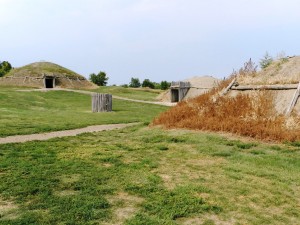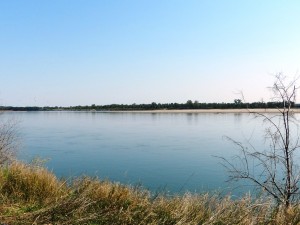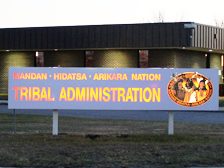» posted on Thursday, August 23rd, 2012 by Linda Lou Burton
Good Things Come in Threes
 Linda Burton posting from Bismarck, North Dakota – A field of corn caught my eye, just outside the gates. It was framed against the backdrop of a gently rounded hill, the shape the same as the rounded earth houses I’d just been inside. I’m at Fort Abraham Lincoln State Park, on the edge of the Missouri River, where re-creations allow a glimpse of the Mandan Village that Lewis and Clark came upon in 1805. The rounded homes in On-A-Slant Village gather in a cluster, each facing the
Linda Burton posting from Bismarck, North Dakota – A field of corn caught my eye, just outside the gates. It was framed against the backdrop of a gently rounded hill, the shape the same as the rounded earth houses I’d just been inside. I’m at Fort Abraham Lincoln State Park, on the edge of the Missouri River, where re-creations allow a glimpse of the Mandan Village that Lewis and Clark came upon in 1805. The rounded homes in On-A-Slant Village gather in a cluster, each facing the  center; solid built; earth packed tightly against the weather and the wind. Inside, beds and benches show a daily way of life; a stone circle for the fire; animal skins for blanket warmth; clay pots, a rake, a hoe, a stack of squash in brilliant orange. These were farmers, who cultivated corn and squash and beans in gardens along the riverbanks. Their crops were bred to flourish here; the modern field corn I see today traces its roots to native stock; their legacy continues.
center; solid built; earth packed tightly against the weather and the wind. Inside, beds and benches show a daily way of life; a stone circle for the fire; animal skins for blanket warmth; clay pots, a rake, a hoe, a stack of squash in brilliant orange. These were farmers, who cultivated corn and squash and beans in gardens along the riverbanks. Their crops were bred to flourish here; the modern field corn I see today traces its roots to native stock; their legacy continues.
 Selection, adaptation and rotation are common concepts in agriculture today. Each was practiced by the Mandan, Hidatsa and Arikara tribes long before Europeans arrived on the Plains. The Mandan garden held the vegetable trio of corn, beans, and squash. Planted together, their yield increased – the corn provided structure for the beans to climb; the beans helped replenish the soil with nutrients; the wide-spreading squash leaves provided cover that conserved water and aided weed control. These crops thrived with minimal environmental impact.
Selection, adaptation and rotation are common concepts in agriculture today. Each was practiced by the Mandan, Hidatsa and Arikara tribes long before Europeans arrived on the Plains. The Mandan garden held the vegetable trio of corn, beans, and squash. Planted together, their yield increased – the corn provided structure for the beans to climb; the beans helped replenish the soil with nutrients; the wide-spreading squash leaves provided cover that conserved water and aided weed control. These crops thrived with minimal environmental impact.
 Their agricultural practices influenced people far beyond their culture. Their farming prowess created surplus; this allowed them to trade their produce to other tribes for hides, and dried meat; later they developed trade with Hudson Bay and American Fur Company traders. French-Canadian explorer La Verendrye, in a written account of the Mandan in 1738, described them as prosperous and powerful. Though they lived peaceful lives along the Knife and Missouri rivers, contact with the outside world brought in diseases like smallpox; by 1862 entire villages were wiped out, forcing survivors to band together. Three tribes – the Mandan, Hidatsa, and Arikara – came together; supporting one another yet maintaining tribal identity.
Their agricultural practices influenced people far beyond their culture. Their farming prowess created surplus; this allowed them to trade their produce to other tribes for hides, and dried meat; later they developed trade with Hudson Bay and American Fur Company traders. French-Canadian explorer La Verendrye, in a written account of the Mandan in 1738, described them as prosperous and powerful. Though they lived peaceful lives along the Knife and Missouri rivers, contact with the outside world brought in diseases like smallpox; by 1862 entire villages were wiped out, forcing survivors to band together. Three tribes – the Mandan, Hidatsa, and Arikara – came together; supporting one another yet maintaining tribal identity.
 Today there are 10,400 members enrolled with the Three Affiliated Tribes. The address for the MHA Nation is New Town, North Dakota, a community on the 980,000-acre Fort Berthold Reservation, which straddles the north and south shores of Lake Sakakawea. Farming is still important to the economy; so is cattle ranching, and most recently, oil and gas activity. The first well in the Bakken formation was drilled on the reservation a little more than four years ago; currently 493 wells are actively producing.
Today there are 10,400 members enrolled with the Three Affiliated Tribes. The address for the MHA Nation is New Town, North Dakota, a community on the 980,000-acre Fort Berthold Reservation, which straddles the north and south shores of Lake Sakakawea. Farming is still important to the economy; so is cattle ranching, and most recently, oil and gas activity. The first well in the Bakken formation was drilled on the reservation a little more than four years ago; currently 493 wells are actively producing.
Read the history of the Mandan- Hidatsa-Arikara Nation and the Three Affiliated Tribes and keep up with current events @ www.mhanation.com
Fort Abraham Lincoln State Park and On-A-Slant Village @ http://www.fortlincoln.com/
Note: Mandan seed stocks, such as the field corn mentioned above, aided in the survival of many arriving European immigrants. The Great Northern Bean, still cultivated in this region, can be traced to a Hidatsa variety.
